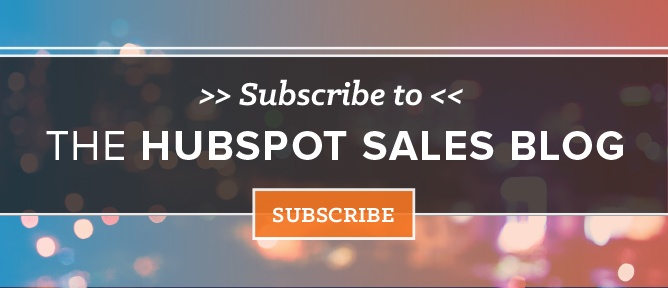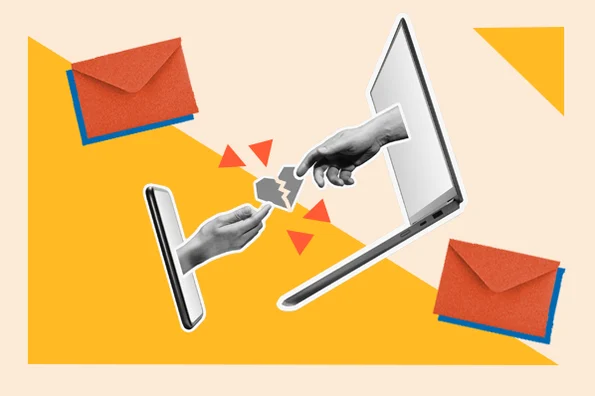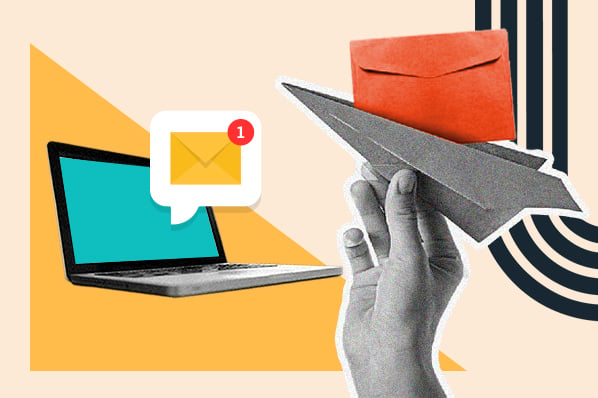
That's probably not the least offensive headline I have ever written but it has to be said.
You might be thinking I have created some false tension to mark my arrival on the HubSpot Sales guest blog post scene, but I assure you, I haven’t. This is something that has been getting out of hand of late and this was a perfect opportunity to share that with you.
Don’t worry. I’m not into bait and switch. I fully intend to explain why I strongly believe much of the advice about cold emailing is BS. Some of it boils down to plain old-fashioned lack of awareness but some of it stems from something far more serious.
I'm here to set the record straight. Let's get started.
1) Don't Worry, Selling Isn’t Needed
This for me is by far the worst element creeping into the cold email scene. As a strong advocate of cold emailing (done correctly) and a passionate salesperson, this is the most worrying theme I see.
I’m a member of many Facebook and LinkedIn groups about lead generation, and the topic of cold emailing frequently crops up.
Often I see questions like: "I have run an email prospecting campaign in which I included a link to my online scheduling service for people to self-service an appointment. I’ve sent out X hundred and had zero response. Can you help with my subject line?" And people respond by offering tweaks in the subject line and the opening pitch.
Stop!
Are you mad? It has absolutely nothing to do with the headline or intro paragraph. The whole strategy is wrong!
No one in their right mind is going to self-service a time in your diary from a cold email. The cold email is there for one purpose only -- to get a response so you can pick up the phone and speak to that person.
It saddens me that there seems to be a whole section of business leaders that believe you can sell without selling.
The cold email is a bridge to a telephone call and nothing else. Yes, there is a huge amount of skill and expertise that goes into a high-performing cold email but don’t ever listen to advice from well-intentioned people who think the email will do the selling job for you. It won't.
2) No Outbound Strategy Required
Cold email subject lines and opening phrases have become the latest cold calling opening lines and elevator pitches. The people that hunt for them do so because they just don't have a strategy and are looking for the silver bullet.
Let me give you a glimpse into a proper outbound strategy based on cold email and how small changes can ramp up to big gains. In this example, I use our "Outbound System Optimization Calculator."
Phase 1: Optimize the Emails Sent
There are two parts to this:
- Send more emails. By prospecting efficiently, leveraging the best technology, maintaining a standard working week schedule, and receiving great coaching and mentoring, it is feasible to see dramatic gains without a reduction in the quality of the cold emails being sent. In the chart below, we've increased the amount of emails sent by 20% -- from 500 to 600.
- Dial down the bounce rate. Experiment with the myriad of new data services that create real-time lists of email addresses -- there are new ones springing up every day. Figure 1 shows a 10% bounce rate which should be easily achievable based on a 30% starting position.
The total result of these two minor changes = a 54% increase in emails delivered.
Yes, I am aware that doesn't take into account the technical elements of deliverability but that's a different blog post by someone more qualified than me.

Phase 2: Optimize Opens and Returns
The two parts to this are:
- Increase the numbers of emails that buyers open. This is the step that nearly everyone seems to be focused on. The key here is not to just focus on the magic opening line but
- a) Test and measure the effectiveness of send times versus open times of your target audience.
- b) Test the effectiveness of the first 140 -160 characters as this is what will show in smartphones. Keep the opening congruent with the headline and don't pitch anything. Also, don’t waste that valuable real estate with “My name is John, and I head up business development with Big Corp." This will put prospects off straight away.
- c) Test and measure subject lines that lead with benefits. There is no magic template. Implement, test, refine, and scale -- that is the magic equation.
- Increase the number of replies. There are many things you can do to increase reply rate, but the single most important is to focus on your "most wanted response." Are you giving them too many options? Are you asking them to self-service a meeting? My opinion is the only response you should be seeking is to get someone to reply to you. This gives you a strong reason to pick up the phone and speak with them.

The total result of a 10% increase in opens and a 150% increase in replies is a cumulative increase of 324%, or from 32 a month to 134 a month.
Phase 3: The Number Of Replies Converted To A First Call
This is a very large omission in many people's strategy.
In our work with clients, we tend to see around a 10% first call conversion rate from email replies. In Figure 3, an increase from 10% to 20% takes the cumulative number of first calls from 3 to 27.
With a tight script and process at this stage, it is relatively easy to achieve a 40%+ conversion on replies to discovery calls.
I lay out our exact script in this blog post which you should be able to implement to bring that level of return.
This is very typical of the type of results we see in a business when they start focusing on their system and reflects the starting and finishing numbers.
And if you can't quite agree with my whole "cumulative" effect concept then serious focus in this one area alone can provide those type of returns.

Phase 4, 5, and 6 of this strategy deal with the conversion rate of calls to business, average deal size, and the number of people prospecting. If you’d like a copy of the Outbound System Optimization calculator download this brilliant whitepaper on how to set up an outbound cold email system and then reply to one of the emails and ask me for a time to run through it with you.
The moral of the story is don't get sucked into the belief that an outbound cold email strategy is based on the power of the pitch or email template. You would be doing yourself a disservice if you did.
3) Ineffectual Language Everywhere
As someone who used to teach cold calling for many years, I developed a concept called "learning by role osmosis." This is a principle where people coming into a telesales or cold calling role seemed to acquire the words and phrases (mostly bad) of those around them.
Cold emailing has quickly adopted this trend.
Whatever your beliefs about cold calling, bad or good, cold calling resulted in some significant body of testing and measuring around what words made a strong impact on your success. Unfortunately, that body of knowledge seems to have been discarded in much of the cold email advice I see on the internet.
Let me give some examples:
Subject line: "Chat about [insert pain point here]"
Using "chat" in cold calling is well known to make conversions tank. The higher in an organization you go, the more emails with "chat" in them will tank.
The reason is fairly obvious. No one has time to chat!
Your prospects are time poor and desperate for results. If all you can offer is a chat and no value, then no one will give you time.
"I'm sorry to bother you ... "
Again, this has been a no-way phrase in cold calling for years. So why is it acceptable in cold emails?
Right from the outset you are:
- Positioning the email as a hassle that is going to waste their time.
- Positioning yourself as subservient to the person.
These are just two examples from many I see in the terrible cold email templates being publicized on the web. If you want to get a strong sales perspective on these things then you can't go wrong with the writings of Jeff Hoffman.
4) The Myth of the Magic Template
An outbound sales strategy is not based on the success of a magical high-converting email template. But this idea is becoming quite pervasive.
Let me demonstrate a few reasons why if all you've got is a cold email template you have copied from the net then you are in trouble:
- A very good writer published a great template they had written for a client. However, within six months I had been emailed the exact same template from five different companies with little change in wording. The result is both the original client and the copy cats will see reduced results from mass adoption of the template.
- A well-known template suggests emailing a few different people in a company for a referral to the appropriate person. However, it was producing zero results for a management consultant. Why? Because the consultant molded his system to a template and not the other way around. He really had to speak to the CEO and no one else. He had the CEO's email address. So he knew exactly who he had to email but got swayed by the appeal of a template rather than relying on his common sense. Once we changed the email to speak to the CEO only his response rate went through the roof.
- A template asking to be pointed in the right direction is failing to pass corporate spam filters due to the sheer volume of people (including spam SEO companies) now sending the exact same template.
Templates are a good starting point, but before you ever start to copy them, run them through a sanity check first:
- Who wrote it?
- Is it likely to be a fit with the tone and style of your marketplace?
- Is it likely to have been used to death in your marketplace?
- Take some of the content and search for it in Google. How many results do you find?
- Is there is anything unusual in the template? Is this necessary for your target prospects?
- Does the template allow for a high level of personalization?
- Would you think it was spam if it was sent to you?
If you’d like to see the origin of many of the templates being used in today's cold email strategies, I’d strongly recommend reading Barking Up a Dead Horse.
We've covered a lot of ground here, so allow me to summarize.
If you want your outbound prospecting to be wildly successful, keep these key takeaways in mind:
- Perfect your system and don’t focus on one minor part.
- Be wary of who you take advice from -- and that includes me.
- Just because you may not be using cold calling, don’t turn your back on valuable lessons that have been learned and developed from thousands of hours of testing. Your medium may be different but you don’t need to start from scratch.
- Don’t override your common sense about what will work or is appropriate just because a person on the internet says it was wildly successful.




![How to Find Almost Anyone’s Email Address, Without Being Creepy [+Expert Tips]](https://www.hubspot.com/hubfs/132_Find%20Email%20Address.jpg)







